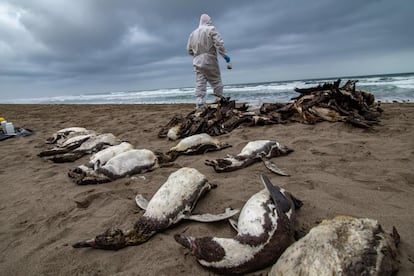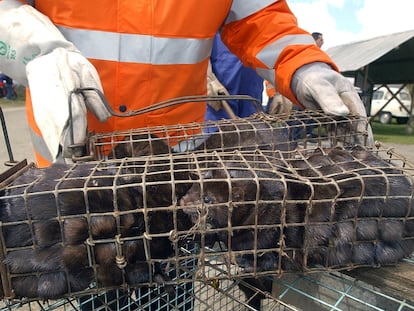The epicenter of the worst bird flu crisis in history, with 250 million birds culled, shifts to Europe
A study on virus evolution warns of imminent outbreaks after November’s large migrations


Humanity is facing the worst bird flu crisis on record. Since the disease’s resurgence in the 2020-2021 season, at least 250 million poultry have been culled around the world to nip outbreaks in the bud, according to data from epidemiologist Vijay Dhanasekaran of the University of Hong Kong. The figures are unprecedented: during this period, over 100,000 wild birds of 400 different species have died, with the disease making worrisome jumps to mammals, such as the one observed at an American mink fur farm in Galicia, Spain, and the massive deaths of sea lions on the beaches of Peru. The new avian influenza virus subtype is everywhere. Dhanasekaran’s team has investigated the pathogen’s evolution. On Wednesday, he warned that “the epicenter” of the crisis has shifted from Asia to Europe and Africa. Experts are bracing for the imminent onset of the typical November outbreaks caused by the arrival of migratory birds from the Arctic.
The current virus’s lineage was detected in geese in China’s Canton province in 1996. Avian influenza viruses have two characteristic proteins on their surface: hemagglutinin (H) and neuraminidase (N). There are 18 types of H and 11 types of N, with a multitude of possible combinations. The Guangdong Goose virus was an H5N1 that could be transmitted rapidly among poultry, causing a hemorrhagic disease with a very high mortality rate of over 40%.
Two different subtypes of influenza can coincide in the same cell of an animal, giving rise to a phenomenon called genetic reassortment, which generates a third subtype, a mixture of the previous ones. Dhanasekaran’s group has detected key episodes in the virus’s evolution. In 2016, a particularly virulent strain of H5N8 originated in ducks in China. In 2020, a subtype of H5N8 classified as 2.3.4.4b emerged in African poultry. In 2021, the H5N1 2.3.4.4b subtype emerged through genetic reassortment in wild birds in Europe; since November of that year, it has caused “unprecedented outbreaks” in wild animals on five continents, according to Dhanasekaran’s study in the journal Nature.
“The shift of the epicenter of these highly pathogenic viruses to new regions has increased the chances of them infecting a wider range of animals, including mammals,” epidemiologist Dhanasekaran warns. The avian flu virus has already been detected in seals, foxes, raccoons, cougars, lynxes and bears, among other species. Exceptionally, humans have also been infected, as in the case of a 9-year-old girl who nearly died after living with sick chickens in a village in Ecuador in late 2022. “Repeated infections in mammals, and in humans, increase the chances of the virus adapting, increasing the likelihood of a pandemic,” Dhanasekaran warns.
The team analyzed the genomes of 10,000 viruses and investigated outbreaks recorded by the World Organization for Animal Health and the United Nations since 2005. The authors note that the virus’s ubiquity in wild birds has accelerated the speed of the pathogen’s spread and multiplied the risk of genetic reassortment. “There is a perpetual threat of the virus jumping to humans. This is mainly due to the virus’s ability to evolve rapidly. It can acquire mutations that help it better attach to receptors on human cells, or it can acquire the ability to transmit via aerosols,” Dhanasekaran explains. “The biggest concern is the genetic reassortment of an H5 [bird] virus with human influenza viruses, which is what happened in previous pandemics, such as the ones in 1957 and 1968.”
Ornithologist Victor Gamarra notes that the current panzootic — the animal equivalent of a pandemic — has affected “hundreds of thousands of wild birds” around the world. The first case of H5N1 in Peru was detected in a pelican on November 13, 2022. The outbreak spread quickly along the coast and by mid-March at least 100,000 wild birds — belonging to 24 species, some of which are endangered — had been found dead, as Gamarra’s team described in a recent study. The pathogen killed 20% of the pelicans in Peru’s protected marine areas. The ornithologist emphasizes that the total numbers are much higher, because his estimates do not include what happened outside protected areas, where half a million birds could have died.
“The virus has spread throughout South America. And it’s no longer just birds, but thousands and thousands of dead sea lions from the Pacific coast to the Atlantic,” laments Gamarra, a researcher at the Natural History Museum of the National University of San Agustín in Arequipa, Peru. “The situation could become even worse when the new bird migration begins soon. A recombination of the virus could occur, and we could possibly be talking about a second wave in South America,” he warns. “This virus spreads fairly quickly, so studies like Dhanasekaran’s may become outdated. That’s this virus’s major threat: we are not prepared to be able to counteract how fast it [spreads].”
Sign up for our weekly newsletter to get more English-language news coverage from EL PAÍS USA Edition









































